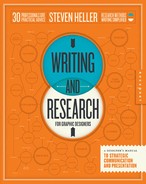
(Ray)
(Fogra 29_WF)Job:08-28858 Title:RP-Writing & Research for Graphic Designers
#175 Dtp:225 Page:162
134-176_28858.indd 162 8/30/12 4:51 PM
(Ray)
(Fogra 29_WF)Job:08-28858 Title:RP-Writing & Research for Graphic Designers
#175 Dtp:225 Page:163
134-176_28858.indd 163 8/30/12 4:51 PM
Writing & research for graphic designers
(Text)
162
EPILOGUE:
is anYBodY reading?
Determining how many people actually read your words was
once difficult. In today’s media world, analytics reign supreme.
If you publish online you are only a few clicks away from learning
almost everything you need to know about who, where, when,
and for how long your readers have engaged with your work.
Or, for that matter, whether you even have any readers. Visits,
hits, page clicks, and bounce backs are all considered as the
measures of success or failure. In addition, social media
encourages users to discuss or critique your work. So you not
only know whether anyone is reading, but you also know
what they think about it. Like? Dislike? How many stars?
And what about entrepreneurial sites, such as Kickstarter.
com? Your finished work is less relevant than your stunning
proposals. Crowd sourcing encourages but can also discourage
the creative act.
All this media attention can make an instant star or abject
failure out of every one of us. If your work does not appeal to
your proposed niche, fuggedaboutit!
There is a lesson for the future to be learned here. And since
I prefer to look at the silver lining, I refuse to sound the death
knell of tradition. Rather, all this attention—or overload, if
you prefer—has a clear benefit. Despite warnings that our
collective attention span is microscopically reduced or our at-
tention deficit disorder is telescopically increased (as I sit at my
computer incessantly clicking the Get Mail button to the right of
my three open Word files), arguably more is being written, more
is being read, more is being learned than ever before.
This surplus—deluge, if you prefer—demands one thing:
For a reader to invest his time (and free up brain storage
space), the writing must be fluid, accessible, and enjoyable to
read. Most important, the content—the research, ideas, and
story—must be worthy of being read. This is not, to borrow a
real estate term, a “writer’s market.” It is a “reader’s market.”
The writer must “sell” the audience. And the audience must
be discerning.
Is anyone reading? Everyone is, in some form and in various
platforms. But as the writer, you must work extra hard to win
their attention, if not their loyalty.
(Ray)
(Fogra 29_WF)Job:08-28858 Title:RP-Writing & Research for Graphic Designers
09-C67944 #175 Dtp:225 Page:162
134-167_C67944.indd 162 9/22/12 11:28 AM
(Text)
163
seleCted BiBliograPhY
The following are informative and inspiring books that will
serve as models for design writing and research. But before
reading these, essential reading is The Elements of Style by
William Strunk Jr. and E.B. White (Longman, 1999), the
classic inspirational and instructional book on writing.
Albrect, Donald, Ellen Lupton, and Steven Holt.
Design Culture Now: National Design Triennial.
New York: Princeton Architectural Press, 2000.
Barringer, David. There’s Nothing Funny About Design.
New York: Princeton Architectural Press, 2009.
Bierut, Michael, et al. (Eds.). Looking Closer: Critical
Writings on Graphic Design. New York: Allworth, 1994.
Bringhurst, Robert. The Elements of Typographic Style.
Vancouver: Hartley & Marks, 2004.
Brody, David, and Hazel Clark (Eds.). Design Studies:
A Reader. London: Berg Publishers, 2009.
Caplan, Ralph. By Design: Why There Are No Locks on
the Bathroom Doors in the Hotel Louis XIV and Other Object
Lessons / Edition 2. New York: Fairchild Books, 2004.
Caplan, Ralph. Cracking the Whip: Essays on Design and
Its Side Effects. New York: Fairchild Books, 2005.
Glaser, Milton. Drawing Is Thinking. New York:
Overlook Hardcover, 2008.
Glaser, Milton. In Search of the Miraculous or One Thing
Leads to Another. New York: Overlook Duckworth, 2012.
Helfand, Jessica. Screen: Essays on Graphic Design,
New Media, and Visual Culture. New York: Princeton
Architectural Press, 2004.
Heller, Steven. Design Literacy (Second Edition).
New York: Allworth Press, 2004.
Heller, Steven (Ed.). The Education of a Graphic Designer
(Second Edition). New York: Allworth Press, 2005.
Heller, Steven. The Graphic Design Reader. New York:
Allworth Press, 2002.
Heller, Steven. Paul Rand.
London: Phaidon Press Ltd., 1999.
Heller, Steven, and Louise Fili. Stylepedia: A Guide to
Graphic Design Mannerisms, Quirks, and Conceits.
San Francisco: Chronicle, 2006.
Heller, Steven. Teaching Graphic Design: Course Offerings and
Class Projects from the Leading Graduate and Undergraduate
Programs. New York: Allworth Press, 2003.
Hollis, Richard. Graphic Design: A Concise History,
Second Edition. New York/London: (World of Art)
Thames and Hudson, 2001.
(Ray)
(Fogra 29_WF)Job:08-28858 Title:RP-Writing & Research for Graphic Designers
09-C67944 #175 Dtp:225 Page:163
134-167_C67944.indd 163 9/22/12 11:28 AM
..................Content has been hidden....................
You can't read the all page of ebook, please click here login for view all page.
